Nokia 2005 Annual Report Download - page 212
Download and view the complete annual report
Please find page 212 of the 2005 Nokia annual report below. You can navigate through the pages in the report by either clicking on the pages listed below, or by using the keyword search tool below to find specific information within the annual report.-
 1
1 -
 2
2 -
 3
3 -
 4
4 -
 5
5 -
 6
6 -
 7
7 -
 8
8 -
 9
9 -
 10
10 -
 11
11 -
 12
12 -
 13
13 -
 14
14 -
 15
15 -
 16
16 -
 17
17 -
 18
18 -
 19
19 -
 20
20 -
 21
21 -
 22
22 -
 23
23 -
 24
24 -
 25
25 -
 26
26 -
 27
27 -
 28
28 -
 29
29 -
 30
30 -
 31
31 -
 32
32 -
 33
33 -
 34
34 -
 35
35 -
 36
36 -
 37
37 -
 38
38 -
 39
39 -
 40
40 -
 41
41 -
 42
42 -
 43
43 -
 44
44 -
 45
45 -
 46
46 -
 47
47 -
 48
48 -
 49
49 -
 50
50 -
 51
51 -
 52
52 -
 53
53 -
 54
54 -
 55
55 -
 56
56 -
 57
57 -
 58
58 -
 59
59 -
 60
60 -
 61
61 -
 62
62 -
 63
63 -
 64
64 -
 65
65 -
 66
66 -
 67
67 -
 68
68 -
 69
69 -
 70
70 -
 71
71 -
 72
72 -
 73
73 -
 74
74 -
 75
75 -
 76
76 -
 77
77 -
 78
78 -
 79
79 -
 80
80 -
 81
81 -
 82
82 -
 83
83 -
 84
84 -
 85
85 -
 86
86 -
 87
87 -
 88
88 -
 89
89 -
 90
90 -
 91
91 -
 92
92 -
 93
93 -
 94
94 -
 95
95 -
 96
96 -
 97
97 -
 98
98 -
 99
99 -
 100
100 -
 101
101 -
 102
102 -
 103
103 -
 104
104 -
 105
105 -
 106
106 -
 107
107 -
 108
108 -
 109
109 -
 110
110 -
 111
111 -
 112
112 -
 113
113 -
 114
114 -
 115
115 -
 116
116 -
 117
117 -
 118
118 -
 119
119 -
 120
120 -
 121
121 -
 122
122 -
 123
123 -
 124
124 -
 125
125 -
 126
126 -
 127
127 -
 128
128 -
 129
129 -
 130
130 -
 131
131 -
 132
132 -
 133
133 -
 134
134 -
 135
135 -
 136
136 -
 137
137 -
 138
138 -
 139
139 -
 140
140 -
 141
141 -
 142
142 -
 143
143 -
 144
144 -
 145
145 -
 146
146 -
 147
147 -
 148
148 -
 149
149 -
 150
150 -
 151
151 -
 152
152 -
 153
153 -
 154
154 -
 155
155 -
 156
156 -
 157
157 -
 158
158 -
 159
159 -
 160
160 -
 161
161 -
 162
162 -
 163
163 -
 164
164 -
 165
165 -
 166
166 -
 167
167 -
 168
168 -
 169
169 -
 170
170 -
 171
171 -
 172
172 -
 173
173 -
 174
174 -
 175
175 -
 176
176 -
 177
177 -
 178
178 -
 179
179 -
 180
180 -
 181
181 -
 182
182 -
 183
183 -
 184
184 -
 185
185 -
 186
186 -
 187
187 -
 188
188 -
 189
189 -
 190
190 -
 191
191 -
 192
192 -
 193
193 -
 194
194 -
 195
195 -
 196
196 -
 197
197 -
 198
198 -
 199
199 -
 200
200 -
 201
201 -
 202
202 -
 203
203 -
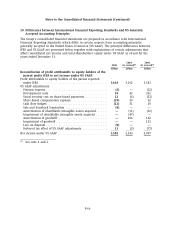 204
204 -
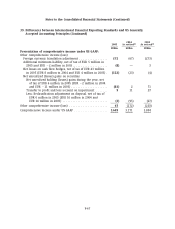 205
205 -
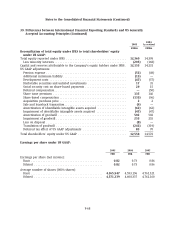 206
206 -
 207
207 -
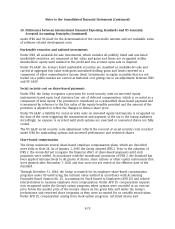 208
208 -
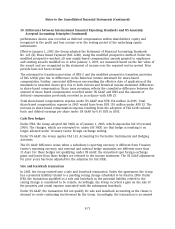 209
209 -
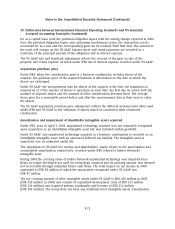 210
210 -
 211
211 -
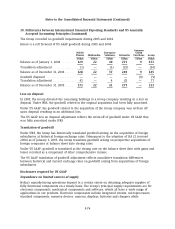 212
212 -
 213
213 -
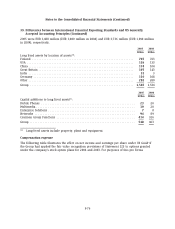 214
214 -
 215
215 -
 216
216 -
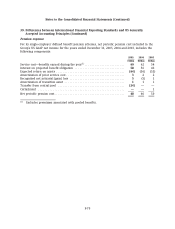 217
217 -
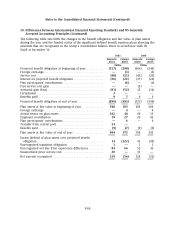 218
218 -
 219
219 -
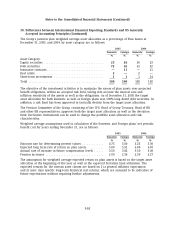 220
220 -
 221
221 -
 222
222 -
 223
223 -
 224
224 -
 225
225 -
 226
226 -
 227
227
 |
 |

Notes to the Consolidated Financial Statements (Continued)
39. Differences between International Financial Reporting Standards and US Generally
Accepted Accounting Principles (Continued)
The Group recorded no goodwill impairments during 2005 and 2004.
Below is a roll forward of US GAAP goodwill during 2005 and 2004:
Common
Mobile Enterprise Group
Phones Multimedia Solutions Networks Functions Group
EURm EURm EURm EURm EURm EURm
Balance as of January 1, 2004 ....... 129 22 40 271 9 471
Translation adjustment ............ (1) — (3) (22) — (26)
Balance as of December 31, 2004 ..... 128 22 37 249 9 445
Goodwill disposed ................ — — — — (9) (9)
Translation adjustment ............ 45 — 4 28 — 77
Balance as of December 31, 2005 ..... 173 22 41 277 — 513
Loss on disposal
In 2005, the Group divested the remaining holdings in a Group company resulting in a loss on
disposal. Under IFRS, the goodwill related to the original acquisition had been fully amortized.
Under US GAAP, the goodwill related to the acquisition of the Group company was written off
upon disposal resulting in an additional loss.
The US GAAP loss on disposal adjustment reflects the write-off of goodwill under US GAAP that
was fully amortized under IFRS.
Translation of goodwill
Under IFRS, the Group has historically translated goodwill arising on the acquisition of foreign
subsidiaries at historical foreign exchange rates. Subsequent to the adoption of IAS 21 (revised
2004) as of January 1, 2005, the Group translates goodwill arising on prospective acquisitions of
foreign companies at balance sheet date closing rates.
Under US GAAP, goodwill is translated at the closing rate on the balance sheet date with gains and
losses recorded as a component of other comprehensive income.
The US GAAP translation of goodwill adjustment reflects cumulative translation differences
between historical and current exchange rates on goodwill arising from acquisitions of foreign
subsidiaries.
Disclosures required by US GAAP
Dependence on limited sources of supply
Nokia’s manufacturing operations depend to a certain extent on obtaining adequate supplies of
fully functional components on a timely basis. The Group’s principal supply requirements are for
electronic components, mechanical components and software, which all have a wide range of
applications in our products. Electronic components include integrated circuits, microprocessors,
standard components, memory devices, cameras, displays, batteries and chargers while
F-74
